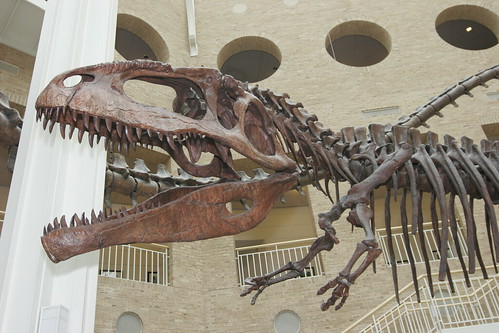
For generations of North American children, Tyrannosaurus rex has reigned as the most fearsome and favorite dinosaur, a tyrant unparalleled by carnivores on any other continent. Recent discoveries in Argentina have dethroned T. rex and raised up a new contender for the title of King Carnivore.
In Philadelphia last week, an audience of children gasped as paleontologists unveiled a 6-foot-long model skull showing Giganotosaurus carolinii, a dinosaur that surpassed T. rex in size.
Rodolfo A. Coria and his colleagues at the Carmen Funes Museum in Plaza Huincul, Argentina, first uncovered bones of Giganotosaurus in 1993 and estimated the dinosaur's length as 41 feet (SN: 9/23/95, p. 199). Last year, the researchers discovered many more bones of the skull, enabling them to reconstruct the animal's head more accurately. Coria now calculates that Giganotosaurus reached 45 to 47 feet long and weighed 8 to 10 tons--making it 10 percent longer and a full 3 tons heavier than T. rex, says Coria.
"It is really very humbling, as a North American, to stand in front of this beast," says Peter Dodson of the University of Pennsylvania in Philadelphia.
There are even larger Giganotosaurus specimens waiting to be discovered, says Coria, who has found pieces of a second that is bigger than the original.
Another challenger for the King Carnivore title is an African theropod called Carcharodontosaurus (SN: 5/25/96, p. 335). Coria estimates that Giganotosaurus was larger than this African giant, which was a close relative.
Paul C. Sereno, a paleontologist at the University of Chicago who discovered a new specimen of Carcharodontosaurus in Morocco in 1995, debates that point. Sereno contends that it is difficult to tell the size range of a species from just a few specimens. Moreover, there are not enough whole bones from the skull of Giganotosaurus to estimate even that specimen's length precisely.
All the paleontologists agree, however, that it is far more important to understand the animals' evolutionary history and their ecological roles than to settle the size contest, Dodson notes that although these giant carnivores were similar in size, "the menu for each animal was very, very different."
T. rex, which lived 65 million years ago at the end of the Cretaceous period, fed on herbivores that were roughly its size or smaller. The 97-million-year-old Giganotosaurus dieted on herbivorous sauropods nearly twice its size.
T. rex's reputation endured further humiliation this week when researchers reported that the dinosaur suffered occasionally from gout. Bruce M. Rothschild of the Arthritis Center of Northeast Ohio in Youngstown and his team discovered sphere-shaped pits--telltale signs of the disease--in the hand bones of several T. rex specimens, they report in the May 22 Nature. Gout is extremely painful and infrequently afflicts modern reptiles and birds, says Rothschild.
"Caricatures of the agony and ill temper of those afflicted with gout are magnified by its recognition in T. rex," the group notes.
Source Citation
Monastersky, Richard. "T.rex bested by Argentinean beast." Science News 24 May 1997: 317. Academic OneFile. Web. 5 Feb. 2010.
Gale Document Number:A19481612



No comments:
Post a Comment